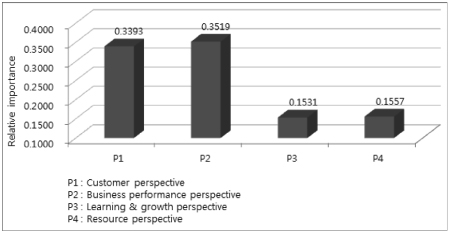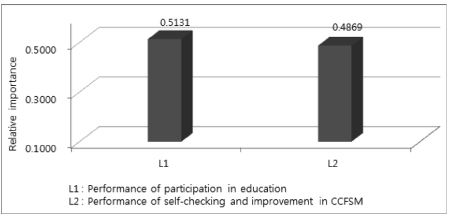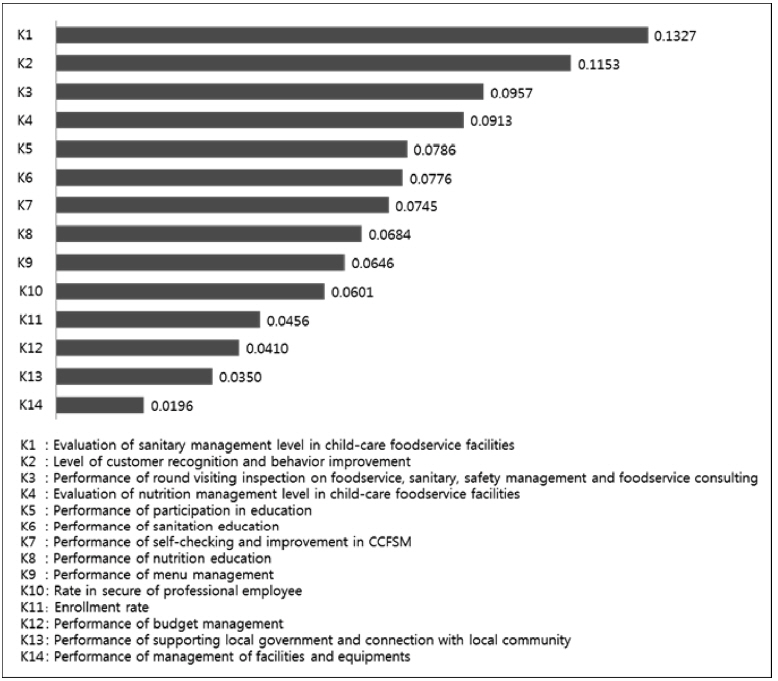Articles
- Page Path
- HOME > Korean J Community Nutr > Volume 18(2); 2013 > Article
-
Original Article
- Analysis of Relative Importance of Key Performance Indicators for Center for Child-Care Foodservice Management through Analytic Hierarchy Process (AHP)
- Yun-Hui Jeong, In-Sook Chae, Il-Sun Yang, Hye-Young Kim, Hae-Young Lee
-
Korean Journal of Community Nutrition 2013;18(2):154-164.
DOI: https://doi.org/10.5720/kjcn.2013.18.2.154
Published online: April 30, 2013
Deptartment of Food and Nutrition, Yonsei University, Seoul, Korea
1)Department of Food Science and Nutrition, Jeju National University, Jeju, Korea
2)Institute of Symbiotic Life-TECH, Yonsei University, Seoul, Korea
3)Department of Food and Nutrition, Sangji University, Wonju, Korea
- †Corresponding author: Hae-Young Lee, Department of Food and Nutrition, Sangji University, 660 Woosan-dong, Wonju 220-702, Korea Tel: (033) 730-0492, Fax: (033) 738-7740 E-mail: hy1317@sangji.ac.kr
Copyright © 2013 The Korean Society of Community Nutrition
This is an Open Access article distributed under the terms of the Creative Commons Attribution Non-Commercial License (http://creativecommons.org/licenses/by-nc/4.0/) which permits unrestricted non-commercial use, distribution, and reproduction in any medium, provided the original work is properly cited.
- 1,120 Views
- 1 Download
- 7 Crossref
Abstract
- The objectives of this study were to assign reasonability to importance of weight selection issue in key performance indicator for performance evaluation of Centers for Child-care Foodservice Management (CCFSM) developed by using Balanced Scorecard (BSC), to draw key performance indicator (KPI) by perspective and to analyze differences in recognition on importance. From September 25 to October 9, 2012, we conducted a questionnaire-based study via e-mail, targeting chiefs and team leaders of nationwide 21 CCFSMs (43 persons), officials of local governments where CCFSM was established (21 persons), officials of Korea Food and Drug Administration (2 persons) and foodservice management experts (27 persons) in order to estimate the relative importance on 4 perspectives and 14 KPIs and analyzed its results by using 61 collected data. The results showed that relative importance of perspectives was estimated in order of importance as follows: business performance (0.3519), customer (0.3393), resource (0.1557), learning and growth (0.1531). Relative importance of KPIs was in order of importance as follows: Evaluation of sanitary management level in childcare foodservice facilities (0.1327), Level of customer recognition and behavior improvement (0.1153), performances of round visiting inspection on foodservice, sanitary, safety management, and foodservice consulting (0.0913). Our results showed that the recognition differences exist on the relative importance of perspectives and KPIs between officials of CCFSM, KFDA, local government and foodservice management experts. These observations will form the basis for developing evaluation systems, and it is considered that performance indicators developed on this basis will suggest direction of operation which CCFSM will have to perform.

| n | 1 | 2 | 3 | 4 | 5 | 6 | 7 | 8 | 9 | 10 |
|---|---|---|---|---|---|---|---|---|---|---|
| RI | 0 | 0 | 0 .58 | 0.90 | 1.12 | 1.24 | 1.32 | 1.41 | 1.45 | 1.49 |
| Characteristics | Frequency (%) | |
|---|---|---|
| Gender | Male | 7 (11.5) |
| Female | 54 (88.5) | |
| Total | 61 (100.0) | |
| Age (years) | 40.6 ± 9.71) | |
| Occupation | Chief of CCFSM | 13 (21.3) |
| Team leader of CCFSM | 27 (44.3) | |
| Officials in executive department related to CCFSM2) | 13 (21.3) | |
| Foodservice management experts (Professor, Researcher) | 8 (13.1) | |
| Total | 61 (100.0) | |
| Career (years) | 11.2 ± 7.9 |
- 1. Chang ML, Kim YB. A study of the actual conditions of kindergarten meals program. Korean J Early Child Educ 2003; 23(3): 261-284.
- 2. Staskel DM, Briley ME, Field LH, Barth SS. Microbial evaluation of foodservice surfaces in texas child-care centers. J Am Diet Assoc 2007; 107(5): 854-859.Article
- 3. Harker PT, Vargas LG. The theory of ratio scale estimation: Saaty\'s analytic hierarchy process. Manage Sci 1987; 33(11): 1383-1403.Article
- 4. Hwang DY, Kang KH, Gim KM, Baek MH. Development of woman farmers center performance indicators by using the analytic hierarchy process. J Agric Extension Community Dev 2008; 15(4): 599-619.
- 5. Jang YL. Development of sustainable eco-tourism evaluation models and indicators: Focusing on the specialist of eco-tourism by AHP analysis. Korean J Tourism Res 2012; 27(2): 455-475.
- 6. Jin JG. Government productivity: Conceptual framework and measures. In: Korean Institute of Public Administration KIPA Research Report. 1998. pp. 0-117.
- 7. Kaplan RS, Norton DP. The balanced scorecard-measures that drive performance. Harv Bus Rev 1992; 70(1): 71-79.
- 8. Kim DK, Park YW, Lee SM. Assessment of tourism resource development by the analytic hierarchy process: Focusing on the planning process. Korea J Tourism Hosp Res 2007; 21(4): 5-18.
- 9. Kim EH. A study on the development of performance evaluation model of the disabled welfare institutions using BSC and AHP. Korean Policy Sci Rev 2010; 14(4): 143-171.
- 10. Kim HK, Sung ES. In: BSC Practice Manual. Sigmainsight; 2004.
- 11. Kim HJ, Lim HG, Kim DG. The development on significancy and priority of KPI in contracted foodservice business in Korea using AHP. Korea J Tourism Hosp Res 2011; 25(4): 163-176.
- 12. Kim ST, Ahn SS, Lee HY. A study on the development of a CSR(Corporate Social Responsibility) evaluation model: with application of AHP(Analytic Hierarchy Process) technique. Acad Customer Satisf Manag 2011; 13(1): 169-187.
- 13. Kim SY, Yang IS, Yi BS, Baek SH, Shin SY, Lee HY. Childcare facility and kindergartens demands on foodservice support by center for child-care foodservice management (CCFSM) inSeoul and Gyeonggi-do. Korean J Community Nutr 2011; 16(6): 730-739.Article
- 14. Kim HK, Kim HJ. The development on significancy and priority of KPI in Korean coffee shop business using AHP. Korean J Hosp Adm 2012; 21(5): 195-205.
- 15. Kim JH, Kim WJ, Cho HK, Lee EY, Seo MW. A study on the development of evaluation model for selecting a standard for DITA using AHP. Ind Eng Interfaces 2012; 25(1): 96-105.
- 16. Ko YS, Yoon HS, Lee JH. In: Performance management in public service. Korea Development Institute; 2004.
- 17. Kwak TK, Lee HS, Yang IS. Assessment of food service management practices in day care centers. Korean J Soc Food Sci 1991; 7(4): 103-109.
- 18. Lee SG. Consolidated performance management for local governments with the introduction of performance-based budgeting system: With special reference to the case of Seoul metropolitan government. Korean J Local Finance 2003; 8(1): 135-162.
- 19. Lee BS. The survey on the foodservice management system of the child care centers in Ansan. Korean J Food Nutr 2006; 19(4): 435-447.
- 20. Lee MA, Yang IS, Yi BS, Kim HA, Park SH. Analytic hierarchy process approach to estimate weights of evaluation categories for school food service program in Korea. Korean J Nutr 2006; 39(1): 74-83.
- 21. Lee MS, Lee JY, Yoon SH. Assessment of foodservice management performance at child care centers. Korean J Community Nutr 2006; 11(2): 229-239.
- 22. Lee WS. Selection of indicator and establishment of system for a functional assessment of green space: Focused on forest green space. J Korea Soc Environ Restor Tech 2012; 15(5): 31-48.
- 23. Park JH. A study on civil administration service current and improvement method of central government. In: Korean Association for Public Administration Summer Consortium. 2000. pp. 553-568.
- 24. Park JH, Han HJ, L KJ, Park BS. Analysis and improvement in performance evaluation system and actual administration. In: KIPA Research Report. 2004. pp. 1-162.
- 25. Park S, Hong YW, Na JK. A method for selecting the evaluation index of defence R&D project by AHP. J Korean Data Inf Sci Soc 2012; 23(5): 961-970.
- 26. Park YM. A study on performance indicator of disabled welfare service. Jeonnam Assoc Public Adm 2001; 8: 413-431.
- 27. Saaty TL, Aczel J. Procedures for synthesizing ratio judgements. J Math Psychol 1983; 27(1): 93-102.
- 28. Saaty TL. In: Fundamental of decision making and prority theory with the analytic hierarchy process. Pittsburg: RWS Publications; 1994.
- 29. Saaty TL. In: Decision making for leader: the analytic hierarchy process for decisions in a complex world. Pittsburg: RWS Publications; 1999.
- 30. Sohn CY, Yang IS. A analysis of relative importance of evaluation categories for hospital food service by analytic hierarchy process. Korean J Food Nutr 2010; 23(4): 470-477.
- 31. Staskel DM, Briley ME, Field LH, Barth SS. Microbial evaluation of foodservice surfaces in texas child-care centers. J Am Diet Assoc 2007; 107(5): 854-859.
- 32. Um DH, Kim DS, Kim TC, Kim ES. A study on the Development of green-tourism performance indicators by using BSC on rural village. J Korean Soc Rural Plan 2006; 12(3): 43-55.
- 33. Wholey JS, Hatry HP. The case for performance monitoring. Public Adm Rev 1992; 52(6): 604-610.
- 34. Yoon SJ, Kim KS, Kang ES. Application strategies on the BSC model of public performance evaluation system. In: KIPA Research Report. 2005. pp. 1-149.
REFERENCES
Figure & Data
REFERENCES
Citations

- Evaluation of Medical Device Aging and Replacement Decisions within Hospital Environments: A User-Centered Approach
Sewon Park, Gihong Seo, Yoonseo Park, Eun-Ji Kim, Haengjun Lee, Munjae Lee, Mihajlo Jakovljevic
Risk Management and Healthcare Policy.2025; Volume 18: 2201. CrossRef - A study on the improvement of evaluation scheme for the installation and operation of Center for Children’s and Social Welfare Foodservice Management: utilizing interviews with center stakeholders and external experts
Jinhyun Kim, Dahye Han, Jieun Oh, Hyun joo Ryou, Ji-Yun Hwang, Kirang Kim, Sohyun Park
Journal of Nutrition and Health.2024; 57(6): 685. CrossRef - The Effect of Hygiene Guidance by Center for Children's Foodservice Management on Food Safety Improvement in Child-care Foodservices in Changwon
Jeong-Min Cheon, Jae-Kyoung Shin, Hye-Kyung Moon
Korean Journal of Food and Cookery Science.2018; 34(6): 653. CrossRef - Assessment of the Effectiveness and Perception of Education by Center for Child-Care Foodservice Management: Focus on Parents of Child-Care and Kindergarten in Seoul
Se-Young Ju, Wan-Soo Hong
Korean Journal of Food and Cookery Science.2018; 34(4): 404. CrossRef - Task Satisfaction, Job Satisfaction, Organizational Commitment, and Turnover Intension of Center for Children's Foodservice Management Employees
Eun Hye Park, Young Eun Lee
Journal of the Korean Society of Food Science and Nutrition.2015; 44(12): 1881. CrossRef - The Assessment of Food Safety Practices and the Effect of Visiting Education on Food Safety Improvement in Children's Foodservice Facilities
Jae-Eun Paik, Hyun-A Lee, Hyun-Joo Bae
Korean journal of food and cookery science.2015; 31(6): 764. CrossRef - Center for Children's Foodservice Management (CCFSM) Employees' Perception of Difficulties in Performing Tasks
Eun Hye Park, Young Eun Lee
Journal of the Korean Society of Food Science and Nutrition.2015; 44(4): 619. CrossRef







Fig. 1.
Fig. 2.
Fig. 3.
Fig. 4.
Fig. 5.
Fig. 6.
Fig. 7.
| n | 1 | 2 | 3 | 4 | 5 | 6 | 7 | 8 | 9 | 10 |
|---|---|---|---|---|---|---|---|---|---|---|
| RI | 0 | 0 | 0 .58 | 0.90 | 1.12 | 1.24 | 1.32 | 1.41 | 1.45 | 1.49 |
| Characteristics | Frequency (%) | |
|---|---|---|
| Gender | Male | 7 (11.5) |
| Female | 54 (88.5) | |
| Total | 61 (100.0) | |
| Age (years) | 40.6 ± 9.7 |
|
| Occupation | Chief of CCFSM | 13 (21.3) |
| Team leader of CCFSM | 27 (44.3) | |
| Officials in executive department related to CCFSM |
13 (21.3) | |
| Foodservice management experts (Professor, Researcher) | 8 (13.1) | |
| Total | 61 (100.0) | |
| Career (years) | 11.2 ± 7.9 |
| Perspective | Relative importance |
|||
|---|---|---|---|---|
| CCFSM (n = 40) | KFDA (n = 1) | Foodservice management expert (n = 8) | Local government (n = 12) | |
| Customer | 0.3330 | 0.3255 | 0.3173 | 0.3685 |
| Business performance | 0.3537 | 0.2578 | 0.3734 | 0.3307 |
| Learning & growth | 0.1703 | 0.0769 | 0.1013 | 0.1453 |
| Resource | 0.1430 | 0.3399 | 0.2080 | 0.1555 |
| Perspective | Key Performance Indicator (KPI) | Relative importance |
|||
|---|---|---|---|---|---|
| CCFSM (n = 40) | KFDA (n = 1) | Foodservice management expert (n = 8) | Local government (n = 12) | ||
| Customer | Evaluation of sanitary management level in child-care foodservice facilities | 0.4023 | 0.4286 | 0.4098 | 0.3363 |
| Evaluation of nutrition management level in child-care foodservice facilities | 0.2639 | 0.4286 | 0.2584 | 0.2782 | |
| Level of customer recognition and behavior improvement | 0.3338 | 0.1429 | 0.3318 | 0.3855 | |
| Business performance | Enrollment rate | 0.1543 | 0.0475 | 0.1251 | 0.0783 |
| Performance of round visiting inspection on foodservice, sanitary, safety management and foodservice consulting | 0.2713 | 0.2653 | 0.2345 | 0.2931 | |
| Performance of sanitation education | 0.2156 | 0.2653 | 0.2465 | 0.2092 | |
| Performance of menu management | 0.1734 | 0.1565 | 0.1959 | 0.2072 | |
| Performance of nutrition education | 0.1854 | 0.2653 | 0.1980 | 0.2121 | |
| Learning & growth | Performance of participation in education | 0.4912 | 0.2500 | 0.0676 | 0.6057 |
| Performance of self-checking and improvement in CCFSM | 0.5088 | 0.7500 | 0.9324 | 0.3943 | |
| Resource | Performance of budget management | 0.2680 | 0.4941 | 0.2934 | 0.2032 |
| Rate in secure of professional employee | 0.3797 | 0.0729 | 0.4598 | 0.3857 | |
| Performance of management of facilities and equipments | 0.1318 | 0.1572 | 0.1044 | 0.1139 | |
| Performance of supporting local government and connection with local community | 0.2205 | 0.2759 | 0.1423 | 0.2971 | |
Mean ± SD Officials of Korea Food and Drug Administration (KFDA) included

 KSCN
KSCN






 Cite
Cite


